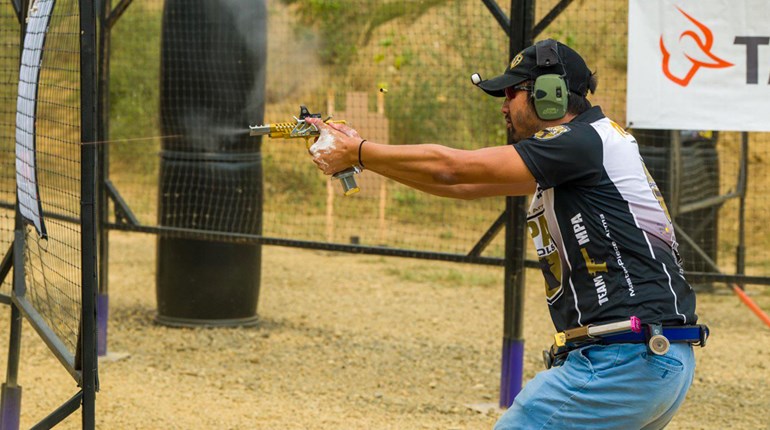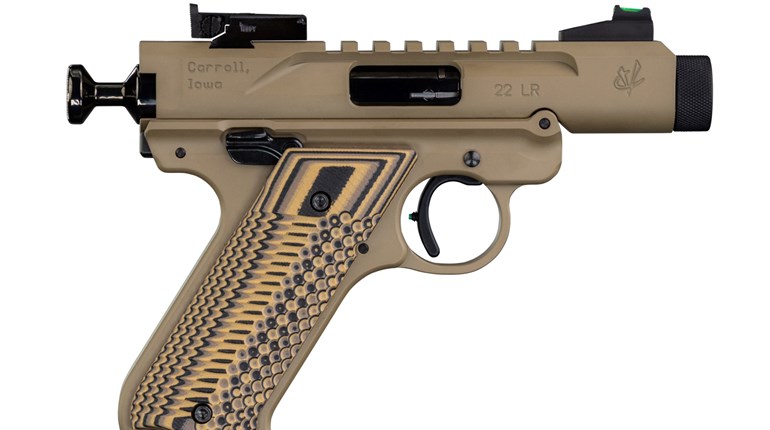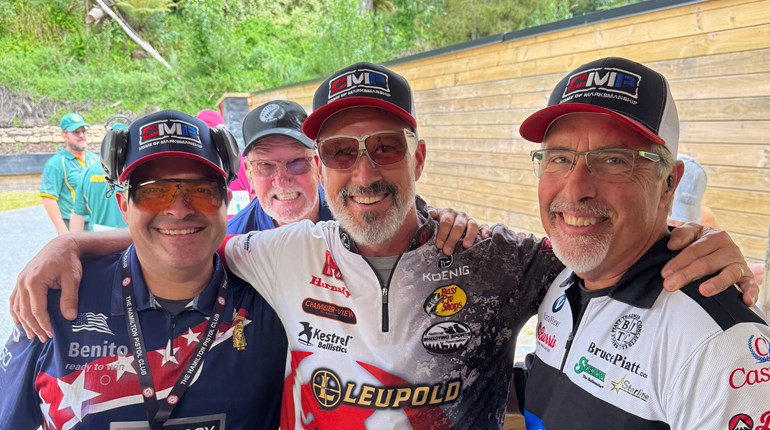
The first impression is difficult to describe. It appears to be a little less German than the traditional 22/45 in appearance, but the family resemblance remains. The gray barrel/receiver assembly offsets the black grip, rail and sights for a nice visual presentation without being flashy. Our test model was Diamond Gray in color.

The grip was the familiar, comfortable 1911 style, which helps make these pistols so very popular. The ambidextrous thumb safety sat in the normal position (it’s refreshing when the design team notices there are left-handed shooters out there). There is a bolt stop/release on the left side of the gun between the trigger and the grip panel, and the magazine release is in the traditional position. The safety, magazine release and bolt stop/release are large enough to use effectively and easily. The size is “just right” on all these controls.
The Ruger Mark IV 22/45 Lite comes with a factory-installed rail that makes mounting an optic easy. The rear sight is fully adjustable, if iron sights are the preference. The Ruger has a threaded barrel; the barrel and receiver assembly is skeletonized from the trigger guard forward. I found the width of the trigger to be very noticeable. I usually prefer a narrow trigger, but the curve of this trigger made it very comfortable.

While I own a couple of single-action Ruger revolvers that have killed more snakes, rats, mice and other vermin around the farm than could fit in a grain wagon, I have never owned a Ruger semi-automatic. The difficult-to-clean reputation was a big factor in staying away, but Ruger has fixed this issue nicely. At the rear of the barrel/receiver is a button that releases the barrel from the frame and the bolt then slides out nicely. The gun comes apart and goes back together easily. I was able to get this pistol taken apart and back together without the owner’s manual or a YouTube video. The first big hurdle with this pistol has been cleared. Ruger has done a fantastic job of making this gun easy to clean and maintain.

I fired a few groups through the Ruger to confirm the sights were on target. I had a few different kids and first-time shooters try it out as well. In these initial sessions there were a couple of jams. I cleaned it up and oiled the gun and shot a few hundred rounds through it without a hiccup. The gun was cleaned and lubed following that and put back on the shelf waiting for a chance to put it through the grinder.
After spending several days over Christmas break with the family watching seasonal movies featuring Bruce Willis, I was ready for some trigger time. Jake Martens and I met up at Parabellum after close on December 26 and we did some shooting. The Ruger 22/45 Lite got the most attention at our little shooting party.

We started with the Ruger pistol and did some rather extensive “group shooting.” We shot Federal copper-plated 36-grain hollow points during this phase and for all the stages we shot. There were over 100 rounds fired through the pistol in the test phase.
The first stage was a slightly modified Smoke & Hope, using USPSA paper targets for the rectangles, and a steel plate at the correct distance for the stop plate. The stage was a little narrower than the official course of fire, to avoid shooting the side walls here. We each ran the stage five times. Jake’s times ranged from a slow of 2.66 seconds to his fastest at 2.06 seconds. Mine ranged from a slow of 2.13 seconds to 1.81 seconds. Neither one of us experienced any malfunctions on this stage. The trigger is smooth and clean and this 22/45 Lite performed just fine at speed.
The second stage we set up was a modified Five to Go. We used paper plates stapled to a USPSA target for the first three plates. The fourth plate was a steel plate and the stop plate was also steel. This course of fire was a little shorter and narrower than Five to Go, with the fourth plate only about 18 yards. Jake and I both enjoyed runs on this stage with no malfunctions. It was impossible to hear the steel ring indoors, but the paint confirmed we had hit the steel plates.

The third stage was a homegrown special. The two steel targets were put on opposite sides of the range to give the largest transition possible. A paper plate was put directly in front of the start position to be our stop plate. The distance to the targets was a full 15 yards. The Ruger Lite was performing like a rock star in this outing so far.
We wanted to test a variety of ammo in the gun, and the gun was plenty dirty, having fired more than 400 rounds in practice, warmup and in the aforementioned stages. We fired two full magazines through the gun with CCI Mini Mags, Remington Golden Boy, Remington Thunderbolt, CCI Standard Velocity and Federal 40-grain. All of these different ammunition types fired without any malfunction.

My initial concerns of ease of cleaning and reliability on the range have been calmed by the live fire testing. The gun ran very well, and it performed at a level that a shooter could be very competitive in Steel Challenge. This gun would be great for plinking as well. The grip is small enough that young hands could reach the trigger and be fundamentally sound shooting this pistol. As the name implies, the gun does not weigh very much, weighing in at a trim 1.5 pounds, and therefore is well-suited for younger shooters.
Jake and I can recommend this gun without reservation. If you are searching for a .22 LR pistol that is fun to shoot, accurate at speed, stylish without being flashy, then the Ruger Mark IV 22/45 Lite is for you. My search for a new .22 LR pistol is over. I’m going to get the family together, go on out to the range and have a few laughs and hand out a few lessons in rimfire shooting.
Article from the March/April 2019 issue of USPSA’s FrontSight magazine.


































